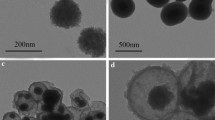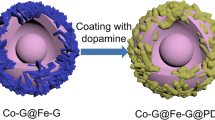Abstract
The yolk-shell Fe3O4@C nanocubes were successfully synthesized through carbothermic reduction process from carbon-coated α-Fe2O3 precursor. The results show that the yolk-shell Fe3O4@C nanocubes are uniformly coated with a thin carbon layer, and a clear cavity about 150 nm in width between Fe3O4 core and carbon shell are formed due to the volume shrinkage during the reduction treatment. The obtained yolk-shell Fe3O4@C nanocubes exhibit excellent cycling stability (the discharge capacity is 709.7 mA·h/g after 100 cycles at the current density of 0.1C) and rate performance (1023.4 mA·h/g at 0.1C, 932.5 mA·h/g at 0.2C, 756.1 mA·h/g at 0.5C, 405.6 mA·h/g at 1C, and 332.3 mA·h/g at 2C, and more importantly, when the current density finally backs to 0.1C, a capacity of 776.8 mA·h/g can be restored). The outstanding lithium storage properties may be attributed to the unique yolk-shell structures.
Similar content being viewed by others
References
Armand M, Tarascon J M. Building better batteries. Nature, 2008, 451(7179): 652–657
Wei Q, Xiong F, Tan S, et al. Porous one-dimensional nanomaterials: design, fabrication and applications in electrochemical energy storage. Advanced Materials, 2017, 29(20): 1602300
Goodenough J B, Park K S. The Li-ion rechargeable battery: a perspective. Journal of the American Chemical Society, 2013, 135(4): 1167–1176
Yu L, Wu H B, Lou X W D. Self-templated formation of hollow structures for electrochemical energy applications. Accounts of Chemical Research, 2017, 50(2): 293–301
Heo J, Liu Y, Haridas A K, et al. Carbon-coated ordered mesoporous SnO2 composite based anode material for high performance lithium-ion batteries. Journal of Nanoscience and Nanotechnology, 2018, 18(9): 6415–6421
Wang Z F, Zhang X, Sun Y, et al. In situ synthesis of nori-derived sponge-like N, P-codoped C/Co3O4 composite as advanced anode material for lithium-ion batteries. Journal of Alloys and Compounds, 2018, 740: 446–451
Xiong Q Q, Tu J P, Lu Y, et al. Synthesis of hierarchical hollowstructured single-crystalline magnetite (Fe3O4) microspheres: the highly powerful storage versus lithium as an anode for lithium ion batteries. The Journal of Physical Chemistry C, 2012, 116(10): 6495–6502
Wu C, Zhuang Q C, Wu Y X, et al. Facile synthesis of Fe3O4 hollow spheres/carbon nanotubes composites for lithium ion batteries with high-rate capacity and improved long-cycle performance. Materials Letters, 2013, 113: 1–4
Cao H Q, Liang R L, Qian D, et al. L-serine-assisted synthesis of superparamagnetic Fe3O4 nanocubes for lithuium ion batteries. The Journal of Physical Chemistry C, 2011, 115(50): 24688–24695
Zhang W M, Wu X L, Hu J S, et al. Carbon coated Fe3O4 nanospindles as a superior anode material for lithium-ion batteries. Advanced Functional Materials, 2008, 18(24): 3941–3946
An Q, Lv F, Liu Q, et al. Amorphous vanadium oxide matrixes supporting hierarchical porous Fe3O4/graphene nanowires as a high-rate lithium storage anode. Nano Letters, 2014, 14(11): 6250–6256
Xin Q A, Gai L G, Wang Y, et al. Hierarchically structured Fe3O4/C nanosheets for effective lithium-ion storage. Journal of Alloys and Compounds, 2017, 691: 592–599
Li H H, Xu R Y, Wang Y P, et al. In situ synthesis of hierarchical mesoporous Fe3O4@C nanowires derived from coordination polymers for high-performance lithium-ion batteries. RSC Advances, 2014, 4(94): 51960–51965
Wang K, Wan G, Wang G, et al. The construction of carbon-coated Fe3O4 yolk–shell nanocomposites based on volume shrinkage from the release of oxygen anions for wide-band electromagnetic wave absorption. Journal of Colloid and Interface Science, 2018, 511: 307–317
Liu W, Song M S, Kong B, et al. Flexible and stretchable energy storage: recent advances and future perspectives. Advanced Materials, 2017, 29(1): 1603436
Liu R P, Zhang C, Wang Q, et al. Facile synthesis of α-Fe2O3@C hollow spheres as ultra-long cycle performance anode materials for lithium ion battery. Journal of Alloys and Compounds, 2018, 742: 490–496
Song L, Zhang S. Formation of α-Fe2O3/FeOOH nanostructures with various morphologies by a hydrothermal route and their photocatalytic properties. Colloids and Surfaces A: Physicochemical and Engineering Aspects, 2009, 348(1–3): 217–220
Zheng Y, Cheng Y, Wang Y, et al. Quasicubic α-Fe2O3 nanoparticles with excellent catalytic performance. The Journal of Physical Chemistry B, 2006, 110(7): 3093–3097
Sun Z Z, Feng X M, Hou W H. Morphology-controlled synthesis of α-FeOOH and its derivatives. Nanotechnology, 2007, 18(45): 199–202
Xiao H, Xia Y, Zhang W K, et al. Template-free synthesis of hollow α-Fe2O3 microcubes for advanced lithium-ion batteries. Journal of Materials Chemistry A: Materials for Energy and Sustainability, 2013, 1(6): 2307–2312
Feng T, Qiao X, Wang H, et al. A sandwich-type electrochemical immunosensor for carcinoembryonic antigen based on signal amplification strategy of optimized ferrocene functionalized Fe3O4@SiO2 as labels. Biosensors & Bioelectronics, 2016, 79(4): 48–54
Fu Y, Wang X, Wang H, et al. An Fe3O4@(C–MnO2) core–double-shell composite as a high-performance anode material for lithium ion batteries. RSC Advances, 2015, 5(19): 14531–14539
Nasibulin A G, Rackauskas S, Jiang H, et al. Simple and rapid synthesis of α-Fe2O3 nanowires under ambient conditions. Nano Research, 2009, 2(5): 373–379
Acknowledgements
The authors acknowledge the financial support from the National Natural Science Foundation of China (Grant No. 51202117), the Natural Science Foundation of Beijing (Grant No. 2162037), the Beijing Nova Program (Z171100001117077), the Beijing Outstanding Talent Program (No. 2015000020124G121), the Fundamental Research Funds for the Central Universities (No. 2014QJ02), the State Key Laboratory of Coal Resources and Safe Mining (No. SKLCRSM16KFB04), the Key Laboratory of Advanced Materials of Ministry of Education (No. 2018AML03), and the Yue Qi Young Scholar Project of China University of Mining & Technology (Beijing) (No. 2017QN17).
Author information
Authors and Affiliations
Corresponding author
Rights and permissions
About this article
Cite this article
Liu, R., Zhang, C., Zhang, X. et al. Construction of yolk–shell Fe3O4@C nanocubes for highly stable and efficient lithium-ion storage. Front. Mater. Sci. 12, 361–367 (2018). https://doi.org/10.1007/s11706-018-0443-y
Received:
Accepted:
Published:
Issue Date:
DOI: https://doi.org/10.1007/s11706-018-0443-y




